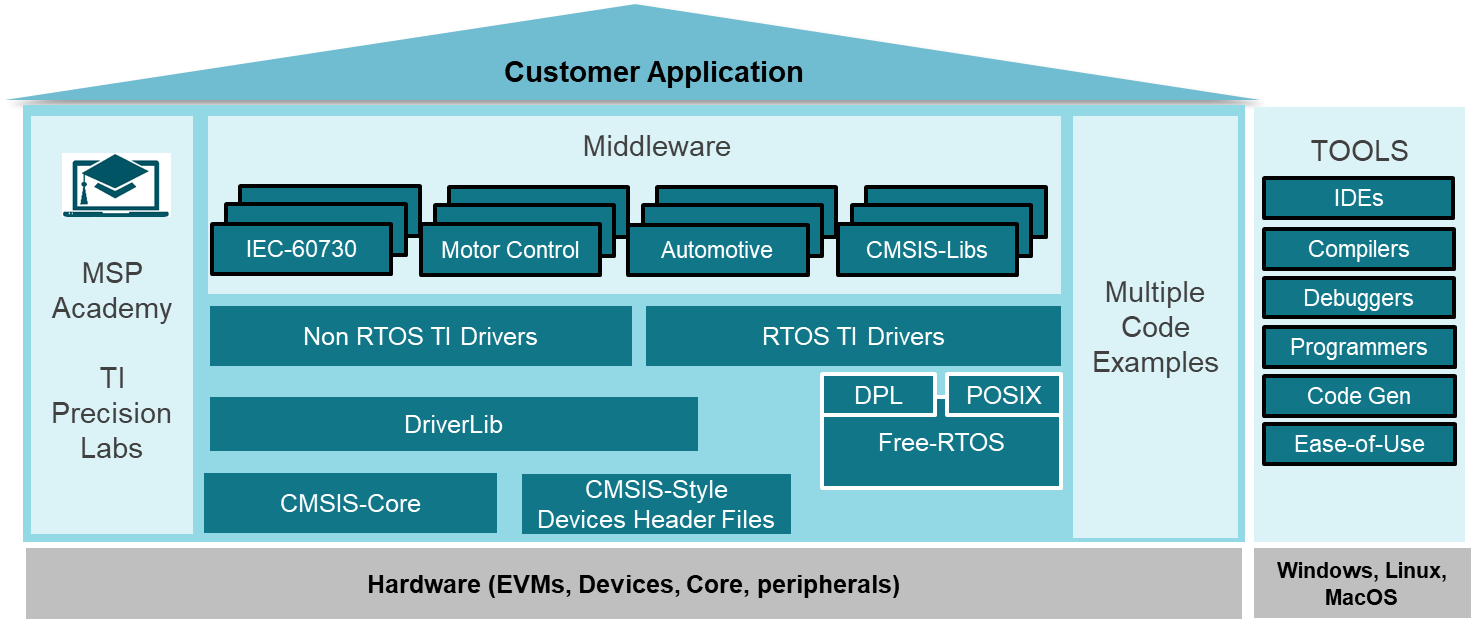SLAAEI9 December 2023 MSPM0C1103 , MSPM0C1104 , MSPM0G1105 , MSPM0G1106 , MSPM0G1107 , MSPM0G1505 , MSPM0G1506 , MSPM0G1507 , MSPM0G3105 , MSPM0G3105-Q1 , MSPM0G3106 , MSPM0G3106-Q1 , MSPM0G3107 , MSPM0G3107-Q1 , MSPM0G3505 , MSPM0G3505-Q1 , MSPM0G3506 , MSPM0G3506-Q1 , MSPM0G3507 , MSPM0G3507-Q1 , MSPM0L1105 , MSPM0L1106 , MSPM0L1228
- 1
- Abstract
- Trademarks
- 1MSPM0 Portfolio Overview
-
2Ecosystem And Migration
- 2.1 Ecosystem Comparison
- 2.2 Migration Process
- 2.3 Example
- 3Core Architecture Comparison
- 4Digital Peripheral Comparison
- 5Analog Peripheral Comparison
2.1.1 MSPM0 Software Development Kit (MSPM0 SDK)
The MSPM0 SDK is packaged with a wide selection of code examples to enable engineers to develop applications on Texas Instruments’ MSPM0+ microcontroller devices. Examples are provided to demonstrate the use of each functional area on every supported device and are a starting point for your own projects. Figure 2-2 illustrates a structure of MSPM0 SDK.
 Figure 2-2 MSPM0 SDK Structure
Figure 2-2 MSPM0 SDK StructureThe MSPM0 SDK can be downloaded from MSPM0-SDK Support software | TI.com. There are four folders included in MSPM0 SDK:
Example: The examples folder is divided into RTOS and non-RTOS subfolders (currently only non-RTOS is supported). These folders contain examples for each LaunchPad™ and are organized based on function with lower-level Driverlib examples, higher-level TI Drivers examples, and examples for middleware such as GUI Composer, LIN, IQMath, and others.
Docs: Includes all relevant documentation including user’s guides and API guides.
Source: Source code and libraries for all drivers and middleware.
Tools: Set of tools to aid in the development and/or testing of MSPM0 applications.
As for STM8, ST povides a standard peripheral library for free, RTOS, bootloader and so on. And STM8 also has a large of Miidleware and application fiedls, like touch-sensing, motor control, Lin library, which MSPM0 almost covers.Most MSPM0 examples support SysConfig to simplify the device configuration and accelerate software development.
Other reference document are shown below: